In most verticals, competition is at an all-time high, and top sales organizations are looking to get the most value from their teams. Effective sales territory management ensures that each outside sales rep focuses on the most impactful activities.
In this post, we’ll explain how to create a winning sales territory plan, share 10 best practices for sales territory management, and finally, we’ll introduce tools that are helpful for managing sales territories of any size.
What is Sales Territory Management?
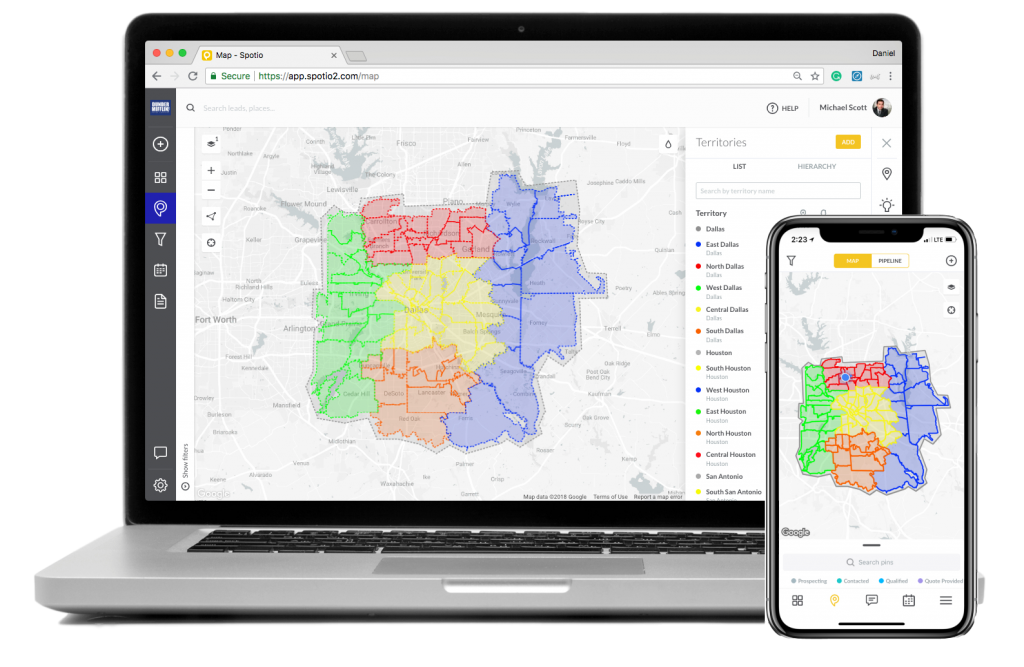
Sales territory management is the process of organizing and managing customers and prospects and sorting them by segment (such as geography, industry, or role). It helps sales teams stay organized, evenly distributes workloads, and improves sales productivity.
Types of Territories
In addition to geographical area, territories can be based on other sales data such as:
- Account type
- Industry segment
- Market potential
- Number of customer accounts
Many field sales teams don’t prioritize sales territory planning; even when they do, they often have trouble adapting and revising based on sales performance.
Why Is Territory Management Important for Outside Sales Teams?
An effective sales territory management plan helps sales managers allocate resources, improve opportunities for sales teams, and hit revenue targets. These are some of the key advantages of territory management:
Cover sales territories more strategically
Sales territory management helps your reps be more productive and ensures your best reps work the top territories and accounts. When reps have clear sales territories, routes, and objectives, they can spend less time planning their days and more time selling.
Assign balanced workloads
Defining sales territories can help you distribute work evenly across your sales team. Keep in mind, though, that sales territory management is an ongoing process. You may need to realign sales territories based on new objectives, personnel changes, or other factors.
Build stronger customer relationships
You can plan your territories to match reps with prospects and customers based on specific characteristics, such as personality or customer lifecycle.
8 Steps to Create a Winning Sales Territory Plan
Sales territory planning is a strategic process that helps businesses divide their market into manageable segments to align sales efforts with customer needs and business objectives. Follow these steps to create a plan that ensures efficient resource allocation, maximizes sales potential, and improves customer satisfaction.
1. Analyze Your Customers
Understanding your customers is the foundation of effective sales territory planning. By identifying distinct customer segments, you can match sales representatives with prospects and existing customers based on shared characteristics, behaviors, or lifecycle stages. This approach enhances personalization and improves the likelihood of successful engagements.
Key factors to consider when analyzing customer segments include:
- Locations: Where are your customers geographically concentrated?
- Budgets: What are their spending capabilities or constraints?
- Products or services purchased: Which offerings resonate most with specific segments?
- Problems solved: What challenges do your products or services address for each segment?
- Buying triggers: What events or conditions lead customers to purchase—or avoid purchasing—your offerings?
- Purchase history: When was the last time they bought from you, and how frequently do they make purchases?
Additionally, identifying unmet needs within the market can reveal new opportunities. For example, if certain customer segments lack solutions for specific pain points, you can craft targeted messaging to highlight how your products or services fulfill those gaps. This proactive approach not only drives sales but also builds trust and loyalty over time.
2. Analyze and Develop Your Team and Resources
The next step in your sales territory plan is to analyze your business’s resources and personnel. You should have an accurate picture of the type and volume of customers that your business can handle.
Note the strengths and weaknesses of your team so you can develop and utilize strengths while simultaneously working to improve any weak areas.
3. Set Measurable Goals
Using the information you gathered about your customers, team, and resources, you should develop goals for your business.
Some goals to consider are:
- Income generated per month
- Number of sales attempts per week or month
- Number of closed sales per week or month
- Ratio of leads to sales closed per week or month
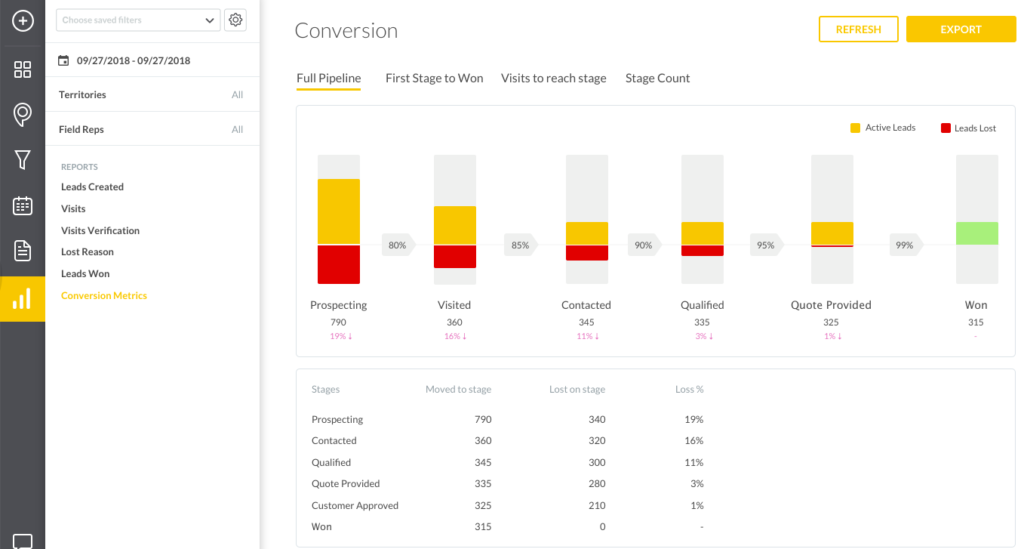
Create a measurable strategy for meeting each of these goals that includes:
Each goal strategy should include:
- Goal statement: What you’re planning to achieve with various sales activities and what’s at stake.
- Key milestones and deadlines: For example, if your goal is to attain $9k in monthly revenue for a given product, you can track progress by breaking the goal into smaller milestones for sales teams, such as $3k by day 10, $6k by day 20, etc.
You can use the SPOTIO sales dashboard to see how your sales team is working toward goals, results for sales territories, and who your sales leaders are.
4. Define Sales Territories
Based on the work you performed in the steps above, you should have an idea of how to divide territories.
It’s important to define the details of each territory, such as:
- Geographic boundaries
- Industry or segment boundaries
- Revenue boundaries
- Product boundaries
- Anything else that may be applicable to your sales organization
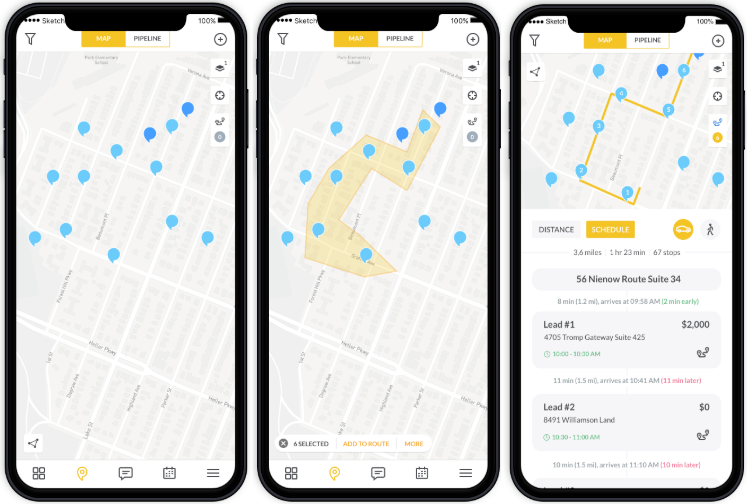
SPOTIO’s mobile Route Mapping feature.
5. Use A Territory Route Mapping App
Sales territory mapping ensures sales teams have time to visit all accounts in their territory. Planning routes used to be a manual process, but the most efficient sales teams use a route mapping app for this important function.
6. Assign Reps to New Sales Territories
Once you’ve determined your new sales territories, you’ll need to decide which reps will cover them. Start this process by looking at the workload of your current team — you may already have the people you need to cover the new territories, or you might need to hire additional staff.
Ensure reps have the right experience for your new sales territories. For example, if you have new sales territories that include several warm leads, you might want to assign your best closers to those territories.
7. Monitor Rep and Territory Performance
To ensure you have the right people covering your new territories, you’ll need to review certain sales targets, such as:
- Sales per client — the dollar value of each rep’s sales per client
- New contacts — the number of contacts your sales reps are bringing into pipeline
- Client acquisition rate — the percentage of leads that sales reps are converting into customers
- Event rates — this could be the number of appointments or calls scheduled, follow-up visits, etc.
- Average deal size — this is the average dollar amount per deal
8. Use Field Data Entry – “Notes as you go”
As you implement your sales territory plan, keep an accurate and up-to-date record of its outcomes using your CRM. This record will help you to track successful aspects of your plan, in addition to what parts of the plan are ineffective. Using this information, you can adjust and optimize your best sales territory plan as needed.
Often, reps have multiple meeting blocks and forget valuable nuggets of information they learned from each meeting. With a sales tool like SPOTIO, reps can jot down/add voice notes using their mobile device and sync them directly into Salesforce.
These mobile field notes are immediately available to your entire team, so reps have complete insight into all communication with prospects and clients.
10 Best Practices for Effective Territory Management
Territory planning is essential for optimizing sales operations and ensuring that resources are allocated effectively. By implementing structured practices, businesses can maximize revenue, reduce inefficiencies, and improve customer satisfaction across their territories.
1. Set Territory-Level Sales Goals
Using the data you’ve gathered about new sales territories, you can define sales goals. These may be specific, quota-based goals — like closing a certain number of deals within a specific time frame or number of visits — or open-ended goals, such as building relationships.
Setting goals is important because it will keep your reps on track. They’ll always know what to work towards next, and you’ll better understand the sales activities they complete every day.
Goals will also help you evaluate your sales department’s efforts. Is your team succeeding? Compare how successful your reps are to achieving the goals you’ve set for them. (Note: to properly track goals, you need to establish metrics for specific territories and KPIs you can use to evaluate individual performance.)
Finally, goals will help you diagnose problems within your department. Are reps failing because they don’t have the necessary skills? Or are they slacking on the job? The right metrics will help you answer these questions. You can then implement a plan to help your reps achieve more team-wide objectives.
2. Prevent Territory Conflict
As a manager, how can you fairly assign territories? And once assigned, how do you ensure reps aren’t poaching accounts from fellow reps? To reduce the risk of territory conflicts, consider the following:
- Number of accounts. The reps who perform better with smaller businesses need more accounts than reps who work with large accounts. Although the number of accounts varies, the total possible revenue goal for each rep should be equal.
- ZIP Code. Make sure sales routes include a reasonable number of stops, in an order that minimizes travel time between appointments.
- Sales territory alignment. Some people connect better with specific industries. Once you identify each rep’s strong suit, give them more accounts with the business types they prefer.
3. Prioritize the Most Valuable Territories
Assign your top performers to high-priority territories.
Keep in mind, the term “top performer” is relative. Your rep with the highest sales-per-client may not be right for a territory containing several small businesses that are slower to make purchasing decisions.
The question is how do you match reps to territories? Start by evaluating your salespeople. What are they good at? How much experience do they have? If you were to rank each rep in terms of ability, how would they stack up to each other? And which products do each individual sell the most of?
Next, consider the customers in each territory. Who are these people? What kind of businesses do they run/manage/work for? What’s their potential budget? And are they able to buy right now?
Finally, take what you know about your reps and the potential customers in each territory and find ideal pairings. For example, you might put your most prolific seller in a territory with buy-ready leads because the short sales cycles will help them close a ton of deals in a minimum amount of time.
Then you could put your second best seller in a territory with the highest-value prospects. They might not close as many deals as your top rep, but they’ll come close. And this configuration will allow each of your top sellers to excel, which will maximize overall revenue numbers for your organization.
4. Track Mileage and Expenses
Outside reps with a lot of ground to cover should receive some degree of compensation for their travel expenses (gas, meals, and basic vehicle maintenance).
Not sure what reimbursement plan is best? We’ve got you covered:
Mileage as a tax deduction
Full-time sales reps and independent salespeople can claim mileage as a tax deduction. The mileage works as an expense, and those with intensive sales routes can write off the standard rate for every mile they drive for work.
Standard mileage reimbursement
Mileage rates are subject to change in each tax year. The standard rates are determined based on market research that determines normal expense ranges for using a vehicle. The 2024 IRS rate for normal business use is 67 cents per mile.
Reimbursement based on sales routes
Salespeople are often reimbursed for mileage using the standard rates or a rate increase based on individual company policies.
Tracking mileage
Diligent mileage tracking is critical for reimbursement. Sales reps must document every mile to receive reimbursement or claim a tax deduction.
A spreadsheet that lists the date, starting mileage, ending mileage, total miles, and notes is easy to store on a clipboard and update daily. Mileage-tracking phone apps are also convenient; they track trips and allow sales reps to make notes about each trip. The best way to track mileage, however, is to use an automated feature — like SPOTIO Mileage Tracking — that records all trips without sales reps needing to remember to log their miles.
5. Create a Rotating Schedule for Contacting Customers
Your reps should contact customers regularly to ensure that their needs are being met. Create a schedule that defines when to contact prospects and customers, and specify the medium — phone call, email, or in-person visit.
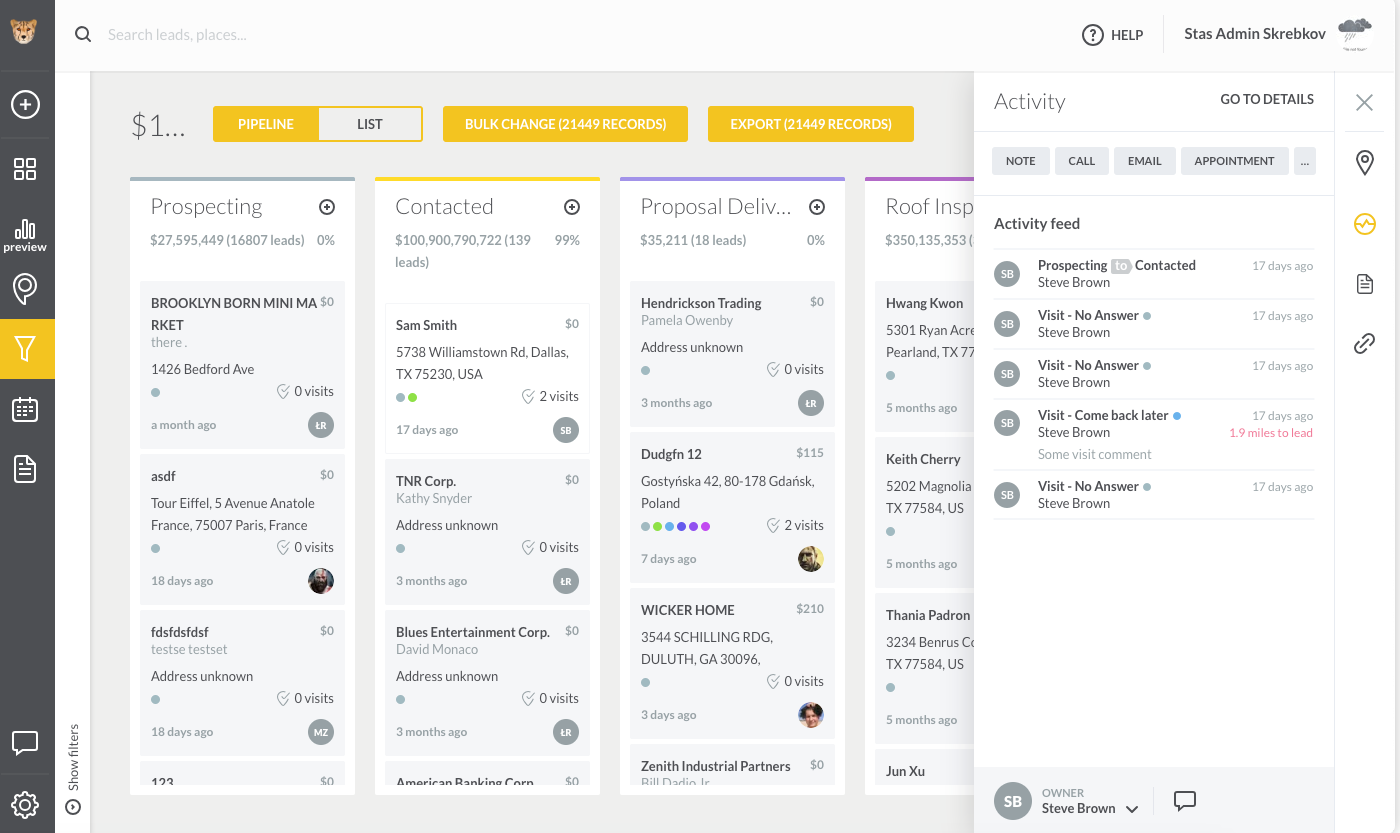
SPOTIO’s scheduling and status view.
6. Meet Needs of Current Accounts While Finding New Leads
The best sales territory management plan should have a dual focus of providing services to high-value accounts while developing relationships with potential new accounts.
High-value accounts are those guaranteed to bring in a higher volume of sales in shorter amounts of time, compared to other accounts. While high-value accounts require attention, it’s also important to cultivate new accounts that will help your company grow.
7. Consider the Seasonal Needs of Customers
Depending on the type of products or services your business provides, your customers may have more seasonal needs. Consider this when deciding when to contact customers and prospects.
Identifying Seasonal Trends
Does your business change based on the calendar? If you’re in solar sales, for example, sales might dip in the winter months, though this likely depends on where your customers are based.
A potential customer in Montana, where the days are short and the snowfall is measured in feet, might not see the benefits of solar in January. But a customer in Arizona, where the sun always shines, will.
This is just one example. There are plenty of other seasonal trends you should watch out for. When you find one or two, apply them to your sales process to see how it affects your bottom line.
Strategic Planning
Identifying season trends is one thing. Adjusting your sales strategy to accommodate your findings is another. You need to get strategic and put your sales reps in the best position to succeed.
Don’t be afraid to change tactics, reconfigure sales territories, or even abandon certain areas altogether if they don’t produce sales. Sales reps can always revisit old territories in the future when they have a better chance to close a deal. Put thought into where your reps should be at all times.
8. Ensure Reps Can Access and Update Data In Real Time
Use technology that allows your sales representatives to update and access customer data in real time. That way all reps can view the most current customer information when needed.
Benefits of Real-Time Data
For our purposes, real-time data can be described as immediate information related to sales activities. Once you and your team have access to real-time data, you’ll enjoy a few benefits:
- Better Engagement: Real-time data will tell reps when prospects take specific actions, like visiting a website or clicking on a link in an email. They can then cater their sales tactics accordingly. This will lead to better prospect engagement, and eventually, more sales. Speaking of which…
- Increased Revenue: Real-time data allows sales reps to engage with prospects at opportune moments. This will help them close more deals, which will produce more revenue. Reps can also use real-time data to take advantage of upsell and cross-sell opportunities.
- Improved Forecasting: Real-time data will give you the information you need to make accurate sales forecasts. You’ll always know which stage of the pipeline prospects are in, and crucially, how long it typically takes prospects to progress to later stages. This will make forecasting easier.
- Sales Coaching Opportunities: Finally, real-time data will tell you how your reps perform in the moment. You can use this information to adjust your coaching efforts. A rep might generate tons of leads, for example, but close very few of them. If so, you can teach them new closing techniques to help them make sales at a consistent clip and increase revenue for your company.
9. Keep Thorough And Up-To-Date Customer Notes
Any communication with customers should be documented and accessible to sales representatives. Notes may include personal information such as the customer’s favorite food, in addition to more sales-specific information such as the customer’s budget.
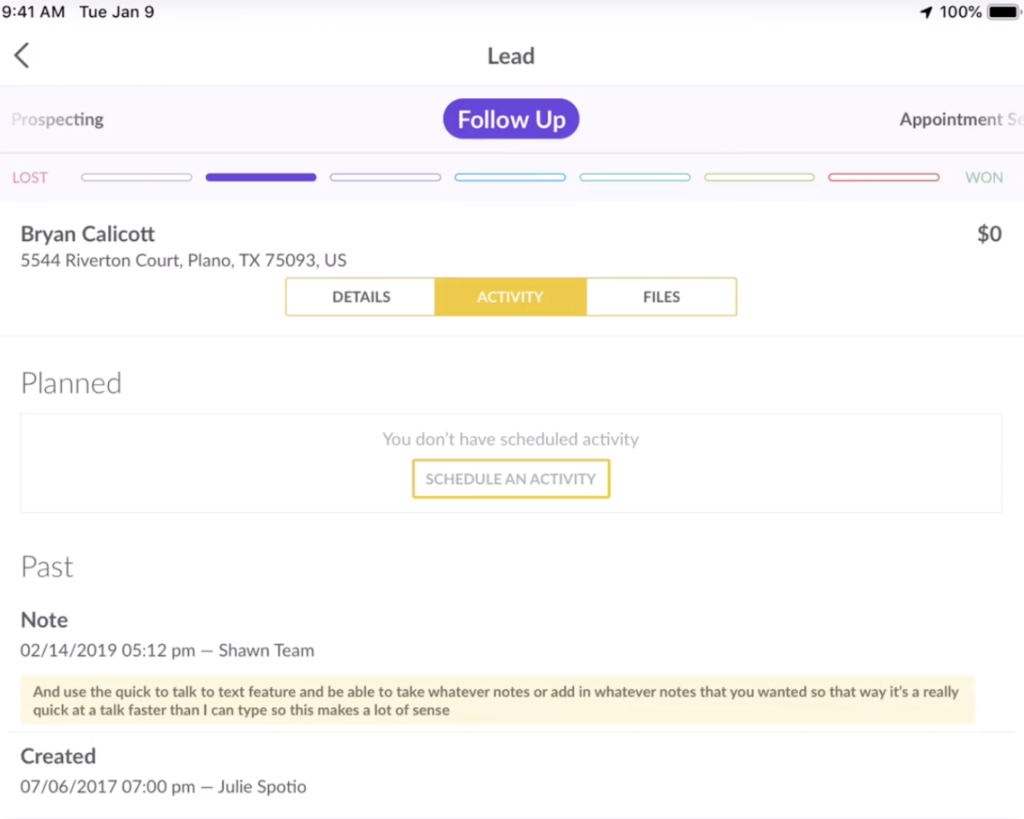
SPOTIO’S note-taking function.
10. Monitor Sales Territory Performance
Frequently review the performance of sales territories and look for trends that might indicate adjustments are necessary. A territory that’s not performing as expected may be a sign that some fundamental factors about it have changed (such as businesses in the area closing or relocating), or that the territory quality is not ideal.
6 SPOTIO Features For Effective Sales Territory Management
An effective sales strategy relies on tools that deliver measurable outcomes, such as improved efficiency, actionable insights, and stronger customer engagement. SPOTIO’s features are designed to help sales teams optimize their workflows, focus on high-value opportunities, and drive better results by leveraging sales data and CRM integrations.
1. Customer Mapping
Customer mapping software empowers sales teams to prioritize opportunities and improve sales territory coverage. By visualizing existing customer locations and overlaying key sales pipeline data, such as pipeline stages or CRM information, reps can identify high-value prospects and plan routes that maximize efficiency. Managers benefit from a clear view of gaps in coverage, enabling them to address underserved areas effectively. This leads to more productive reps, reduced travel time, and engagement with more customers.
2. Sales Tracking
Real-time field sales tracking ensures managers have full visibility into rep activities and territory performance. This allows them to quickly identify where reps are excelling or struggling, enabling targeted coaching to address performance gaps. With activity reports and insights into completed tasks and customer interactions, teams can align their efforts with organizational goals while ensuring consistent progress through the sales pipeline. The result is a more focused team, better resource allocation, and improved overall sales performance.
3. Territory Manager
SPOTIO’s Territory Manager helps businesses maximize the potential of their sales territories by streamlining territory creation and assignment. Managers can assign sales reps using insights into territory performance, such as revenue generation or lead conversion rates. Clear boundaries reduce disputes over lead ownership, keeping sales reps organized and focused on their assigned targets. By aligning territories with business objectives and minimizing overlap, companies can improve resource allocation and ensure comprehensive market coverage.

SPOTIO’S color-coded sales territory management view.
4. Route Planner
SPOTIO’s Route Planner helps field reps maximize their time in the field by reducing travel time and ensuring punctuality for appointments. Arriving on time strengthens customer relationships by demonstrating professionalism and reliability—key factors in building trust with clients. By optimizing routes based on schedules and priorities, reps can focus on meaningful interactions rather than logistics, leading to more productive days and better customer outcomes. Through GPS integration with apps like Google Maps or Waze, Route Planner can help avoid delays by rerouting for street closures or heavy traffic.
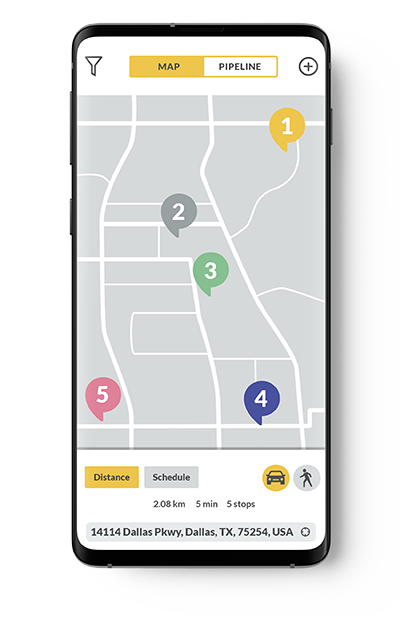
5. Lead Machine
SPOTIO’s sales intelligence feature, Lead Machine, enables teams to focus on high-quality leads within their target markets. By pre-screening prospects using over 200 data points—such as income, location, or industry—reps can prioritize leads that align with their ideal customer profile while avoiding unqualified prospects. This ensures a stronger sales pipeline with higher conversion potential. Managers can also retarget areas efficiently using saved criteria, maintaining consistency in lead quality over time. The result is better prospecting strategies, higher productivity, and improved revenue outcomes.
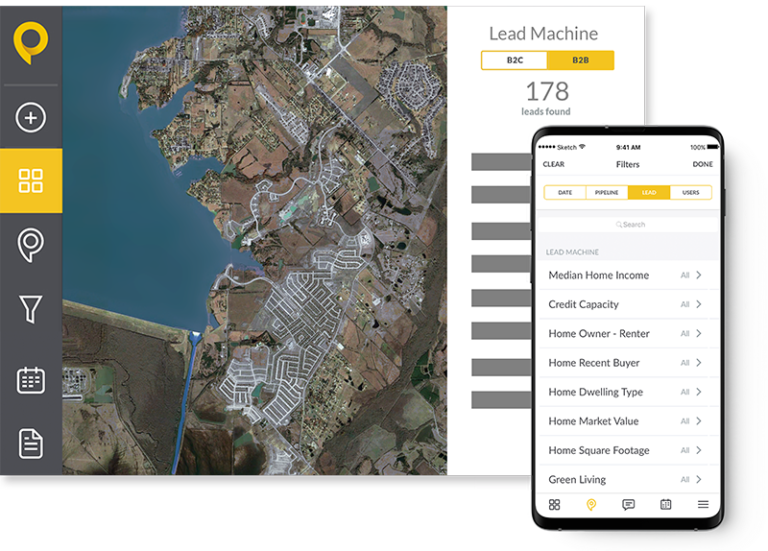
6. My Reports
My Reports provides actionable insights that help managers make data-driven decisions about territory management and team performance. By focusing on key metrics such as revenue by territory or rep activity levels, users can identify trends that require attention or adjustment. Mobile access ensures that reports are available in the field for real-time decision-making, fostering collaboration across teams while improving accountability and transparency across the organization.
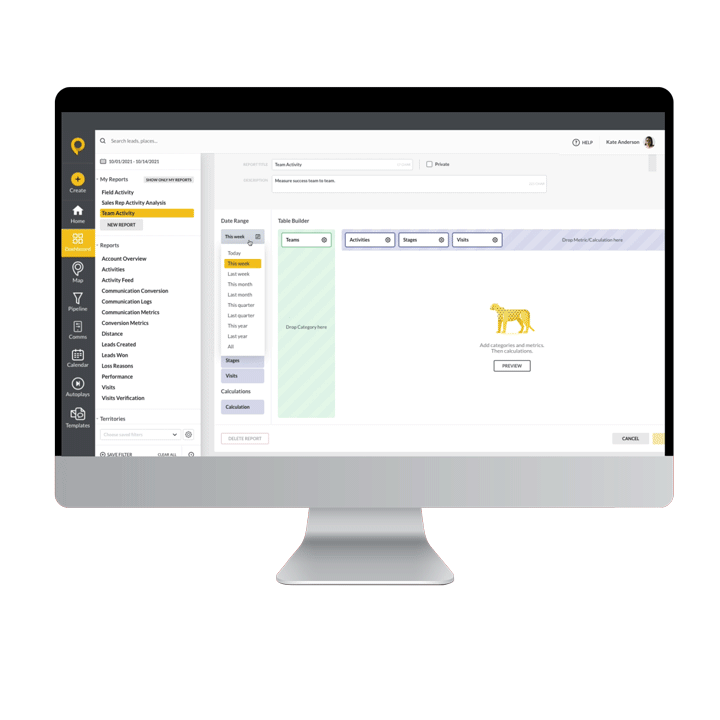
Sales Territory Management FAQ
How should I divide sales territories?
While managers generally consider geography when splitting up territories, you may also want to consider factors such as prospect company size, number of opportunities, and short-term versus long-term potential. Also, consider the strengths of your team members. One sales rep may be a great closer, while another is best at fostering new relationships.
How do you manage territories in Salesforce?
Managing territories in Salesforce is easy, with SPOTIO’s integration features. (See our blog post on this topic for more information).
Will SPOTIO integrate with my CRM and essential business apps?
SPOTIO integrates with more than 2,000 apps, including Zoho CRM, HubSpot CRM, and Netsuite ERP.
Our business has national, regional, and local territories. How would I set up those territories in SPOTIO?
With SPOTIO, you can set up territory hierarchies, giving managers access to all territory data, but restricting sales rep access to any parent territory data.
Simplified Sales Territory Management
Sales territory management can help your business grow by collecting and organizing all information and automating administrative tasks.
SPOTIO’s cloud-based territory management software gives you the insights you need to effectively manage your sales team and helps reps keep track of important information when they’re in the field.
________
SPOTIO is the #1 field sales engagement and territory management app to increase your revenue, maximize your profitability, and increase your team’s productivity in just 2 weeks.
Want to see a product demonstration? Click here to see how SPOTIO can take your sales game to the next level.



